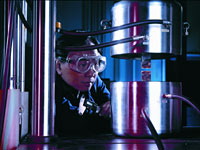|
|||||||||||
| Mechatronic Engineering | |||||||||||

Mechatronic Engineering is the hybrid discipline of mechanics, electronics and computing. It describes a new concept in the world of making value added products. In the past, mechanical engineers, electrical engineers and computer engineers needed to co-operate to develop a product from concept to customer. Industry now needs a skilled engineer who can manage all three disciplines simultaneously, especially at the design stage to create "intelligent machines", e.g. cameras, robots, washing machines, etc., the demand for which is continually increasing.
Mechatronic Engineers are often involved in work at the cutting edge of technology and so the work is challenging and exciting. Many machines can have their performance enhanced by making them mechatronic. Machines designed and manufactured in Australia, such as washing machines and dishwashers, automotive engines and automatic transmissions, as well as numerous machines used for production and in agriculture, have a significant mechatronics component. Thus, the career prospects for Mechatronic Engineers are excellent. Studying Mechatronic Engineering at UNSW The study of Mechatronic Engineering is primarily though the School of Mechanical and Manufacturing Engineering (www.mech.unsw.edu.au). Please refer to the table below for a list of programs available at UNSW.
Mechatronic Engineering can be studied as
|
|||||||||||



